How Big is the EFL? English Football League in Numbers

Image: “King Power Stadium” by Pioeb, originally uploaded to Wikimedia Commons; licensed under Creative Commons Attribution-Share Alike 4.0 International (CC BY-SA 4.0)
When we speak about English football, we often think of the Premier League—which is widely seen as the best league in world football.
But below it sit three fully-professional tiers composed of 72 clubs who form the English Football League, or EFL.
With clubs that compete in terms of revenue, attendances and viewership with some of the rest of the world’s top flight teams, the EFL should not be overlooked, and this article will highlight the current EFL landscape.
The EFL: A Brief History
The EFL was founded as the Football League in 1888, making it the oldest football league in the world.
From this point until 1992, the Football League consisted of the country’s top four divisions until the First Division broke away as part of a rebrand to what we now know as the Premier League.
Despite the Premier League now being a separate entity from the EFL, the same general competition principles still applied, in that clubs could still be promoted to the top flight from the second division, with relegated Premier League sides going the other way.
Some changes occurred in the following seasons, including the Premier League dropping from 22 to 20 clubs for the 1995/96 campaign. The Football League then incorporated the surplus clubs, increasing its size from 70 to 72 clubs.
The 2004/05 season saw the first major rebrand of the Football League, renaming its three divisions. The First Division (which was in reality the second tier of English football, one below the Premier League) was renamed the Football League Championship. The Second Division was changed to Football League One, while the Third Division was renamed as Football League Two.
The second major rebrand came in 2016, when the Football League changed its own name to the English Football League (EFL) today.
Attendances to Rival Top Global Leagues
Being the first football league in the world means the clubs that are part of it are some of the world’s oldest. With that then comes a long history of entrenchment of clubs in their local communities, producing extremely passionate fanbases.
Every week, tens of thousands of these fans travel the country to follow their club, contributing significantly to 72 local economies.
In the 2023/24 season, the EFL accumulated an overall attendance figure of 23.7 million.
Of the 23.7 million, just over half came from the EFL Championship, which recorded a higher attendance than La Liga, the Bundesliga, and the Serie A during the same season, making it the second-highest attended league in Europe.
In the Championship, there are 10 clubs with stadium capacities of over 30,000 and only three with less than 20,000. Amongst these clubs, Leicester City the league in average attendances at this point in the season, with 30,572—consistently filling over 94% of the ground.
In League One, it’s Bolton Wanderers who boast the highest attendance figures so far this season with over 21,000 on average.
As for League Two, Notts County, who were relegated from the top flight in 1991—the season before it became the Premier League—have an average attendance of 9,300. Attendance figures remain high throughout the rest of the league, where the overall average attendance is 5,340, giving England’s fourth tier a higher average attendance figure than the French, Spanish, and Italian third tiers, who all sit in the 3,000s.
A large part of why attendances are so high is English football’s famous ‘3pm blackout’. This was introduced in the 1960s, and is a measure used to encourage fans to attend lower league games by preventing matches from being shown on UK TV between 14:45 and 17:15 on Saturdays.
EFL Finances
In the 2023/24 season, impressive attendance figures meant matchday revenues reached a new high of £210 million in the Championship.
This played a part in an overall record-breaking year for the second division when it came to revenue, with the 24 clubs earning a combined £958 million, compared to £752 million the year before, and £676 million in the 2021/22 season.
This near-billion pound figure is incredibly high for a second division, and is nearly three times that of France’s Ligue 2.
However, expenditure is also high. According to Deloitte, clubs in the Championship had operating losses worsened by 25% to an average of around £17 million per club.
In League One, the losses, similar to its revenue, remained broadly in line with previous years and stood at an average of £5.2 million per club, and in League Two the figure was around £2.3 million.
Often, a lot of this cost is offset by equity injections from a club’s owners, and the willingness to do so varies heavily throughout the EFL. This investment can result in success, with Leeds United’s owners investing heavily and eventually getting promoted to the Premier League last season. The lack thereof, however, can conversely lead to clubs falling down the divisions amidst financial issues in what is an increasingly expensive footballing environment to operate in.
As part of a long-term strategy to improve financial sustainability across the football pyramid, plans for an Independent Football Regulator were approved by the UK Government earlier this year. This involved the passing of the Football Governance Act.
With record attendances, increasing revenues, and the prospect of tighter financial oversight, the EFL is establishing itself as the strongest pyramid system in the world.
At GIS, 79% of our graduates are working in the sports industry, many of whom are at EFL clubs. To learn more about the courses we offer that can be part of your entry into the sports industry, click here.
Article by Zakaria Anani
You may also be interested in

Latest news
December 10, 2024 |
GIS to host C-Suite Executive Course in Miami
Read Post

Latest news
October 7, 2025 |
How Big is the EFL? English Football League in Numbers
Read Post

Latest news
August 11, 2025 |
Take Yourself Out of Your Comfort Zone: Joleon Lescott on his Post-Retirement Studies with GIS
Read Post
Our Partners













